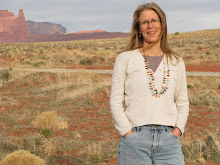
Another winter blizzard has just blown right over our valley, leaving ten inches of snow at Monarch, our local ski area, but none here in town. We only got the wind, huge blustery gusts lofting dirt and trash into the air as the storm blew down-canyon and out onto the Plains.
No matter the weather, I'm thinking spring. I've ordered seeds for our kitchen garden from my favorite seed purveyor, Rene's Garden Seeds. You can buy cheaper seeds, but if you love the flavors and colors and textures of food, you can't go wrong with Rene's seeds. She's a cook as well as a horticulturist, and she picks her varieties for the table and the garden.
Last year we grew three varieties of tomatoes from Rene's offerings: small, sweet red and yellow pear tomatoes, Romas for cooking, and crimson carmello, a heritage ribbed type with gorgeous crimson flesh that is low in acid and bursts with flavor. At the end of the season (late September here in the Rockies at 7,000 feet elevation), we brought in 72 pounds of tomatoes off of eight plants to ripen in the house. We were eating fresh tomatoes until December. This year I'm going to grow those three varieties again, plus Rene's new "Summer Feast" trio of heirloom tomatoes: 'Black Krim,' 'Sweet Persimmon,' and 'Italian Costoluto.' I'll start the seeds indoors in early March in flats on a heat mat in our bedroom, my defacto greenhouse because it gets the best sun. By late April, those sprouts be ready to go into the garden, each protected inside the insulating cone of its own wall-o-water.
Last year's kitchen garden got a little out of control (that's our Great Dane in last summer's garden above). Besides the tomatoes, we also grew three kinds of basil, tri-color beets, 'City Lights' chard with its neon-bright yellow, orange, pink, and crimson stems, peas, cilantro, four kinds of summer squash, including a buttery pale green hybrid between yellow crookneck and zucchini that was delicious even when the squashes hid from us and grew huge, broccoli, crisp and mild Mediterranean cucumbers, dill, mesculn lettuce blend, spicy stir-fry greens, spinach, pak choy, rhubarb, and strawberries. (We had asparagus and raspberries as well, but neither yielded much last year. It could have been the hot and dry spring followed by an unusually wet late summer.) We ate from the garden every day, savoring the treat of simply walking out the back door and picking our dinner, fresh and fed by the sun. (We don't use pesticides or synthetic fertilizers.)
When people ask me why we go to all the work to grow a kitchen garden, I want to take them outside and pick a sun-warmed yellow pear tomato and hand it to them. "Close your eyes and just taste it," I would say. Then 'd the smile grow on their face as the flavor explodes on their tongue. "That's why." It's not work, anyway. I do it for love: love of the smells and sounds and tastes of the food the garden produces, and of the community of plants and their partners - the swallows, hummingbirds, butterflies, native bees, and even the garter snake that burrows into the cool shade under the raised beds and eats the slugs and earwigs - that bring our garden alive.
I can hardly wait until those seed packets arrive. I can almost smell the tomatoes ripening.







